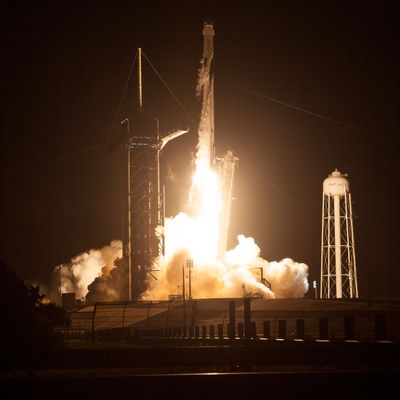
A new four-astronaut team blasted off into space early Friday morning, starting a 23-hour trek to the International Space Station, aboard a previously flown capsule from Elon Musk’s commercial rocket company SpaceX. The mission, dubbed Crew-2, is the latest flight under NASA’s Commercial Crew Program.
SpaceX’s Falcon 9 rocket put on a breathtaking show when it vaulted into space, with the glow from the rocket’s engines lighting up the darkened predawn sky. “Watching a launch from Kennedy Space Center never gets old for me. I’ve watched many launches and watching a predawn launch is especially exciting and just visually stunning,” NASA’s acting administrator, Steve Jurczyk, said at a post-launch news conference. “I could not be more proud of the team.”
Aboard SpaceX’s Crew Dragon capsule Endeavour were NASA’s Shane Kimbrough and Megan McArthur, French astronaut Thomas Pesquet, and Japanese spaceflyer Akihiko Hoshide. The crew, which includes three men and one woman, should reach the ISS early on Saturday morning, where they’ll be stationed for a six-month mission. They will join the Crew-1 astronauts, who launched in November, before the latter team’s Crew Dragon capsule, Resilience, returns to Earth.
“Glad to be back in space, for all of us, and we’ll send our regards to Crew-1 when we get there,” Kimbrough said moments after the capsule separated from the second stage.
Shortly after the crew reached orbit, the Falcon 9 rocket’s first-stage booster descended back to Earth and touched down safely on a landing platform floating in the Atlantic, on a drone ship affectionately named Of Course I Still Love You.
The launch marks a number of firsts for SpaceX, including the first time that people have launched a previously flown rocket booster and capsule, and the first time that two different international astronauts have ridden aboard one of its spacecraft. When the capsule reaches the ISS, it will also mark the first time two Crew Dragon capsules will be docked at the station at the same time.
Due to its reusability, NASA is counting on the Crew Dragon to become the workhorse vehicle for trips to and from the station, lowering the cost of access to space. Another human mission, dubbed Crew-3, is set to take place in the fall, sending another team of astronauts for a separate six-month stint on the space station.





























